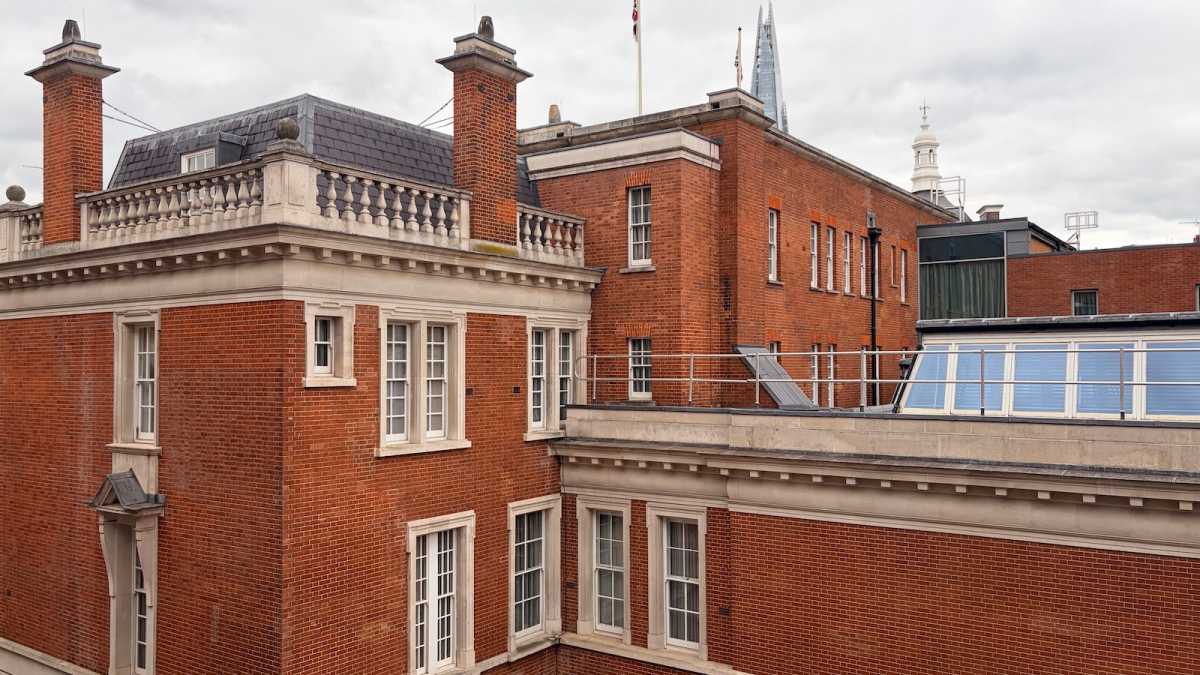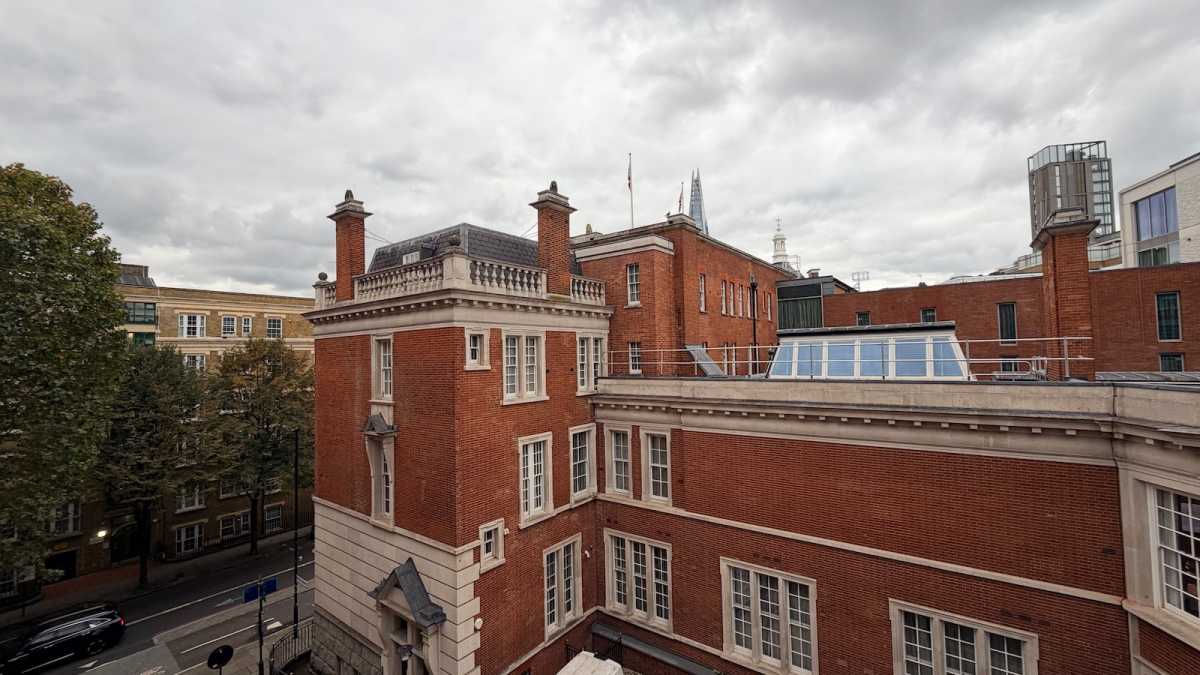At a glance
Expert’s Rating
Pros
- More storage for the same price as last year’s model
- 120Hz ProMotion and Always-On Display
- Centre Stage and Dual Capture camera features for socials
Cons
- AI features are still hit and miss
- Camera could be improved
Our Verdict
After seasons of incremental upgrades and some significant bumps this year, the iPhone 17 has reached a point where it delivers a surprising amount for its price point. Its display and performance are top-notch, its battery life is solid and charging is quick, and it has a great blend of high-end and fun features. If you’re mulling over an upgrade, this is the time to do it, and this is the model to get.
Price When Reviewed
This value will show the geolocated pricing text for product undefined
Best Pricing Today
Best Prices Today: Apple iPhone 17
Not all iPhone line-ups are created equal. If you’re not someone who upgrades each year, some iterations are skippable, and some will give you much more bang for your buck.
2024’s iPhone 16, for example, was fairly missable. Yes, there was a decent camera upgrade, but because of the focus on Apple Intelligence features – some of which have still come to nothing – its most notable innovations were the Camera Control and Action buttons, and they’re not universally loved.
Then there are the vintage years, and for the base model iPhone, 2025 is one of these. We can speculate that, because of the potential selling power of the eye-catchingly redesigned Pro models and the slender new iPhone Air, Apple felt comfortable showering its base model with upgrades, safe in the knowledge that iPhone fanboys and fangirls would still opt for the pricier models.
But if you’re more concerned with quiet quality, you’ll get a lot for your £799/$799 with the iPhone 17.
Design & Build
- Same size, larger screen than last year
- Tougher screen protection
- 5 colour options
Let’s be real. The iPhone 17 looks very much like the iPhone 16. It’s a phone that’ll be incredibly familiar to anyone who’s left the house in the last year.
But there’s a reason Apple has been slowly refining its base model design and that’s because it’s simple, elegant and lovely. It’s leant into that elegance this year with five colour options that perhaps err slightly on the side of tastefulness: black, white, mist blue, lavender and (everyone’s favourite) sage green.
I have the white model in to test and in person, it’s very attractive. My only criticism, and that’s largely for the purposes of this review, is that it doesn’t come out well in photos: its matt, colour-infused back glass is ghostly and all the pics I’ve taken of it look like examples of paranormal photography.
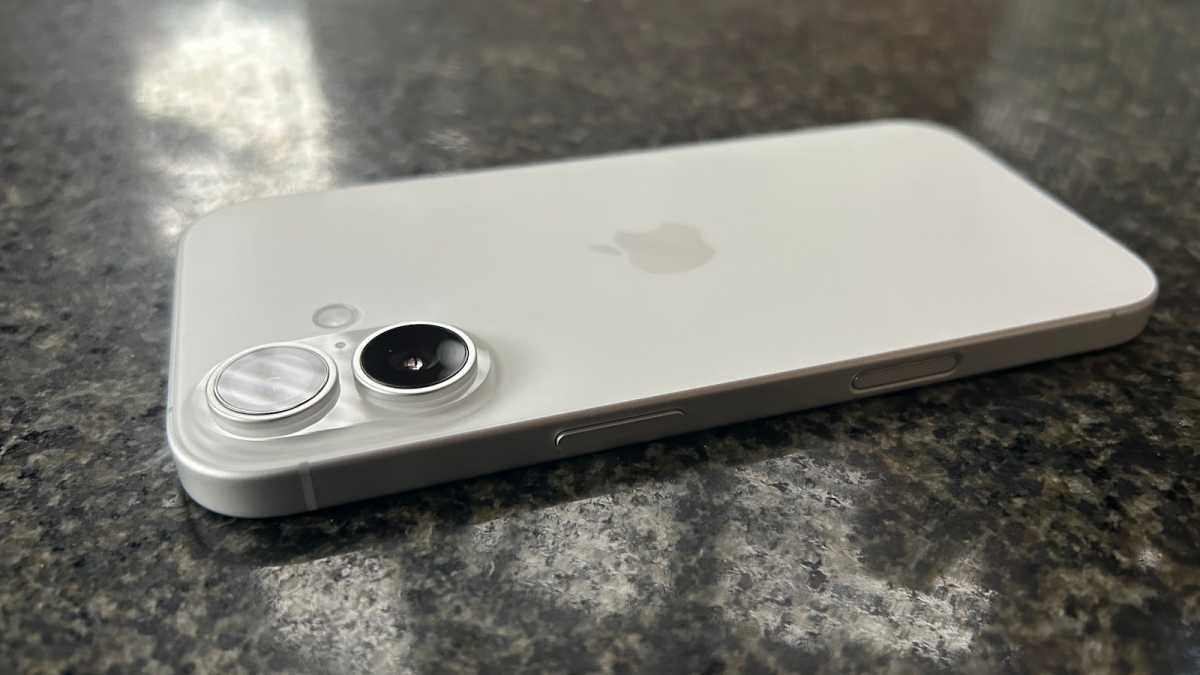
Emma Rowley / Foundry
The iPhone 17 is the same size (149.6mm x 71.5mm x 7.95mm), as last year’s model, with the same matt aluminium frame and rounded corners. However, the screen size has increased ever-so-slightly from 6.1 to 6.3 inches, reducing the bezel to a narrow frame. It’s a minor revision, but one that brings it in line with Android rivals such as the Pixel 10.
Apple claims that the ceramic shield protection on the screen is three times as scratch-resistant as last year’s model, so I’m living life on the edge without a screen protector. But, despite receiving a few knocks, it’s still pristine.
Bear in mind that there’s no ceramic shield on the back glass, which is one of a number of reasons we’d always suggest buying and using a case. I’m using an official Apple silicone case with MagSafe in a subtle shade of lurid neon yellow that’s nice enough but seems pricey (£49.99/$49.99) for what it is.
Another reason is that the back glass is slippery and, unless you want to clutch at your phone with a death grip, it’s easy to drop. However, the phone is light in the hand at 177g, and unless you’re a lover of big phones, its size is just about ideal.
It’s small enough to fit in an evening bag or most pockets, large enough to comfortably watch videos on, yet not large enough to break your nose if you drop it on your face while scrolling.
There’s an argument to be made that there are more buttons than are strictly necessary
Apple says that the iPhone 17 is water resistant to a depth of 6 metres for up to 30 minutes, but I won’t be the person to test this claim. In terms of official ratings, its IP68 verifies it for a dunking in up to 1.5m of freshwater and ensures it’s fully dust-proof.
There are five physical side buttons. Of the three on the left, two are for volume and above them is the Action button, which you can use to switch to silent, enter focus mode, Shazam a song (which is such a great feature), instantly translate and more.
On the right is the Side button, to power down or summon Siri, and below it the Camera Control button, which you can use to open and then control the camera.
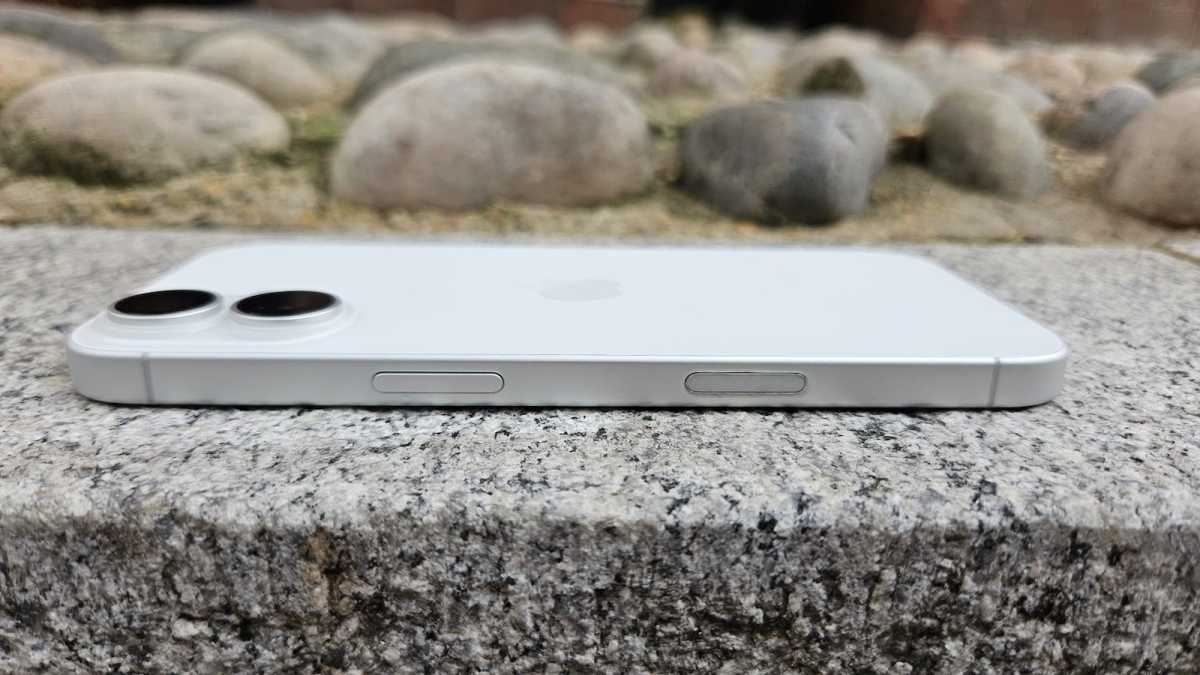
Emma Rowley / Foundry
I don’t love the camera button because it’s not where I want it to be, but as I’m left-handed, that’s often the case for me. Still, my right-handed colleagues don’t seem to be wowed by it either.
There’s an argument to be made that there are more buttons than are strictly necessary, especially when you factor in programmable accessibility features such as back taps, but if you don’t use them, you can switch them off.
Elsewhere, I keep haptics switched off but if you use them for calls and alarms, you’ll find they’re nicely judged, and powerful enough to alert you from a pocket or on a desk.
Screen & Speakers
- Always-On display
- 3,000 nits peak brightness
- 120Hz refresh rate
Some of this year’s key upgrades are to the screen and the way you use it.
What remains the same is that it’s a Super Retina XDR display, a high-spec OLED panel that provides a vivid viewing experience, with excellent colour reproduction.
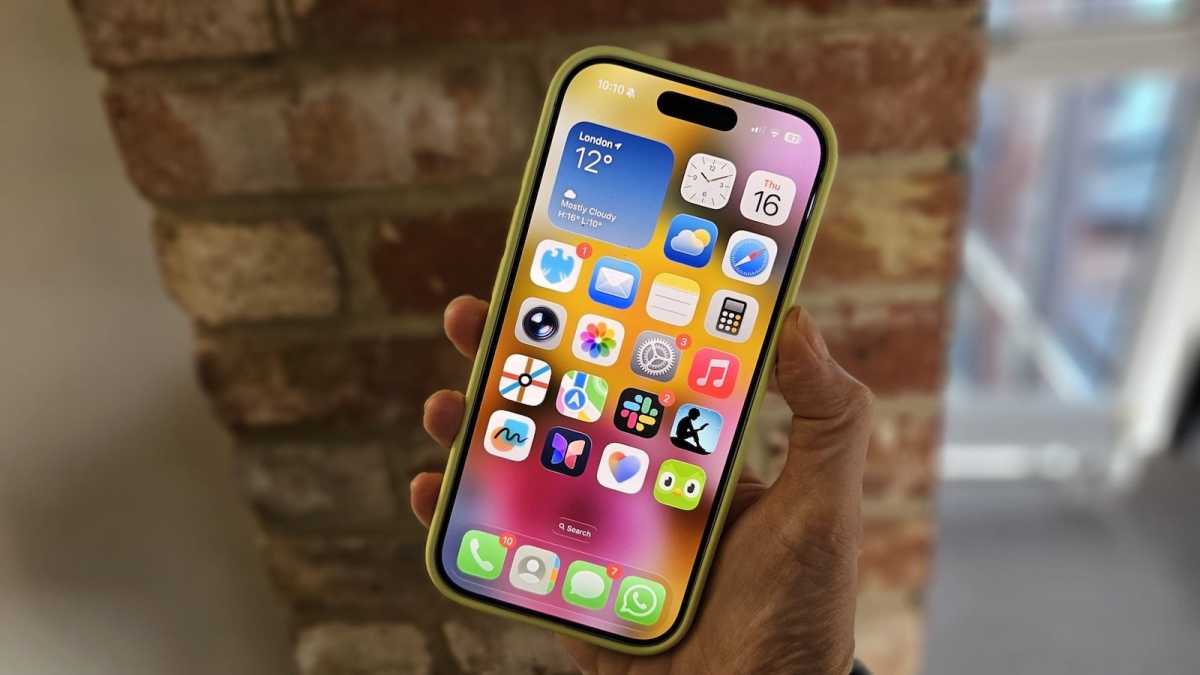
Emma Rowley / Foundry
While it still has the same typical (1,000 nits) and HDR (1,600 nits) brightness, and still drops down to 1 nit minimum brightness to protect your eyes if you pick it up in a dark room, it now peaks at 3,000 nits for outdoor use. This makes a big difference when using your phone outside.
My previous phone was an iPhone 14, which peaked at 1,200 nits, which is just not enough to read outdoors on a sunny day – so this is a favourite upgrade for me.
Another change is the refresh rate. For the first time, Apple has given its base model ProMotion technology, which means adaptive refresh rates of up to 120Hz.
If you’ve come from a 60Hz phone, what this means for you is that your display may look smoother and more responsive. You’re most likely to spot the difference when gaming (minimising stutters and lag), but you might also notice it while scrolling.
What this means for me is there’s one less thing my Android-wielding colleagues can mock my iPhone for, 120Hz being standard across flagship and mid-range Android models.
It now peaks at 3,000 nits for outdoor use. This makes a big difference
ProMotion is one of the features that’s facilitated another upgrade: the Always-On display. The key advantage of this is that you can always see the time and any notifications at a glance.
But to my mind, there’s a disadvantage in that the addictive glowing rectangle I carry around with me is always drawing attention to itself. I’ve found more and more that I unconsciously pick it up while watching a film or chatting to someone. If you don’t like the Always-On feature, you can turn it off in Settings. And I’ll definitely do that soon.
The final thing to mention about the screen is Dynamic Island, which arrived on the base model last year. It’s an interactive pill-shaped feature at the top of the screen that works as part of the Face ID authentication system and gives you controls and information for a number of native app features, including timers, music and phone calls.
One of the best things about it is that you don’t need to figure out how to use it. It’s just there when you need it. That’s because it solves a problem you’re actually likely to face: how to quickly access one app when you’re in another.
There’s good news in terms of audio, too. Finally, the iPhone 17 has a decent pair of speakers that deliver clear sound when you’re on a call or watching a video.
They’re even good enough to listen to music at close quarters, although you’re obviously not going to be enjoying a very bassy experience, and it will distort if you go too loud. But I used to bring a Bluetooth speaker into the bathroom for shower music – now I just iPhone and go.
Specs & Performance
- Apple A19 chip
- 256GB/512GB storage options
Apple has given the iPhone 17 another fresh chip upgrade this year, to the A19. The A19 is a 3nm chip, with a 5-core Apple-designed GPU.
The A19 matches or betters the A18 Pro chip from last year’s Pro models in terms of performance benchmarks. This again speaks to the iPhone’s value for money – the 16 Pro launched in September 2024, starting at £999/$999.
This year’s Air and Pro models run on the A19 Pro, so once again, all models are using the same series of chipset.
This phone is a champ when it comes to multitasking
The iPhone 17 does feel seamless in use. Scrolling is stutter-free and gaming is smooth, although downloading and playing large games such as Genshin Impact will still warm up the phone, but not to a concerning degree. And casual games are a doddle.
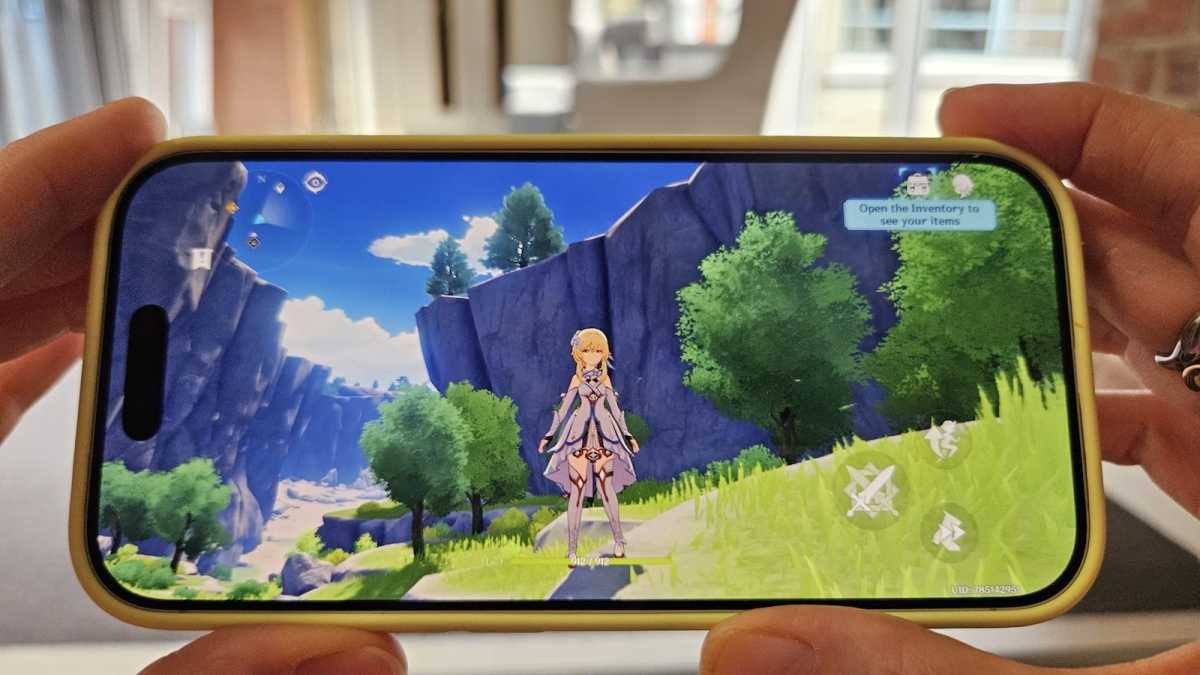
Emma Rowley / Foundry
The hardware-accelerated ray tracing means that graphics-heavy games display with more visual depth and again, less chance of stuttering performance.
This phone is a champ when it comes to multitasking. While working, I tend to open apps as I need them, pasting from Safari to Slack or uploading images, jotting down notes in meetings and sometimes composing articles in Pages, with the result that I can have more than a dozen apps open at a time. But I’ve yet to have a problem or a crash.
This year, the base model starts with 256GB of storage, with the option of 512GB for £999/$999.
iPhone 17 benchmarks
Cameras
- 48Mp main and 48Mp ultrawide rear lenses
- 18Mp selfie camera
- Centre Stage and Dual Capture features
The camera module looks exactly as it did last year, with two lenses stacked at the top left. It’s a neater arrangement than the diagonal formation on the iPhone 15. The only problem with the positioning is, if you use your phone without a case, it will rock annoyingly when placed on a tabletop.
But in terms of specs and performance, there are upgrades from last year. While the 48Mp main camera remains the same, the ultrawide has been bumped up from 12Mp to 48Mp. The lens can capture much more data, which means more detail. It can make a difference in macro shots and it’s useful to anyone who wants to print their photos.
The ultrawide has a 120° field of view and 13mm focal length, compared to the roughly 75° of the main 48Mp Fusion lens, with its 26mm focal length. It’s easy to use: just choose 0.5x from the focus options or pinch the screen.
When reviewing the iPhone 16 last year, my colleague Chris Martin, who’s an excellent photographer, took issue with some of the default camera settings, including the fact that they’re hidden away in the iPhone’s main settings menu and aren’t accessible from the camera app.
But that’s because the iPhone camera is designed for someone like me, who is notably not a photographer, but rather a person who points their phone at nice-looking things and expects a nice-looking photo to appear.
And, generally speaking, it does. The iPhone 17’s colour reproduction is excellent and images rarely look over-processed.
Choose Portrait and you’ll get a decent shot of a friend. If the background bokeh doesn’t provide enough contrast, you can adjust it afterwards by playing with depth.
Hold your phone very close to a flower, and the macro will kick in, giving you a rich, detailed shot of the petal and stem.
The iPhone camera is designed for someone like me, who is notably not a photographer
Low-light photography, however, is still not particularly impressive. It’s come a long way since the iPhone 14, whose low-light shots were uniformly grainy. But I live in the city and the iPhone 17 struggles with light pollution, opting to flood most nighttime shots with a weird grey light. Even so, the detail and crispness are much improved compared to three generations ago.
Even less impressive is the zoom. The iPhone 17 has a 4x optical zoom range, from 0.5x on the ultrawide to 2x on the main lens, but the images it produces at 2x, especially in low light, are pretty blurry and are unlikely to make it into your favourites folder.
Beyond this, it has a digital zoom of up to 10x, but this is achieved (as it is on pretty much any camera phone without a telephoto lens) by enlarging and cropping the image without adjusting the lens. So, if you’re a frequent gig-goer and regularly want to snap pics of a faraway stage, you might want to invest in an iPhone 17 Pro model – or go for one of our recommended camera phone picks.
But Apple knows its audience, and it has added a couple of cool new features to its selfie camera.
The first is bringing Centre Stage to its front camera. By using a larger, square sensor instead of the traditional rectangular one, the iPhone’s software can compose the shot as needed to keep you – and any friends you’re posing with – in the middle of the frame.
This means you don’t have to turn your phone from portrait to landscape to get everyone in. After playing around with it for a while, I can say it does work, although it’s not quite as dynamic as it appears in Apple promos.
The second is a video feature involving both cameras. Switch on Dual Capture and you’ll record what you’re looking at (gigs and sporting events seem the most likely use cases) and your own reaction to it.
While I can’t see myself using it, I’ve already spotted Dual Capture videos a few times on Instagram and TikTok. Well played, Apple.
Battery Life & Charging
- 30 hours’ video playback
- MagSafe charging
Apple says that video playback has increased to 30 hours on the iPhone 17, up from 22 hours on the iPhone 16. This indicates quite a significant boost in battery life.
During the week, I’m a heavy phone user. I start the day reading the news or a book on my phone. I have Slack open all through the working day, and I generally listen to music while I work as well. If I run or go for a walk in the evening, the iPhone comes with me for music and my running app. Then there’s usually a bit of scrolling before bed.
At the weekend, when I’m not on my phone as much, I can get almost two days of use
Despite all of that, I can still get through a day without needing to charge the iPhone 17.
At the weekend, when I’m not on my phone as much, I can get almost two days of use before I have to plug it in. The iPhone 17 comes with a USB-C charging cable, but, as you’d expect now, no adapter.
Having previously used an iPhone that charged via Lightning cable, USB-C is a huge upgrade. Unusually, I don’t mind Apple’s proprietary technology – but it has to be better than alternatives, which the Lightning cable was very much not.
But you don’t need to use a cable at all, as the iPhone 17 supports MagSafe charging accessories, as well as wider Qi2 charging, something Android is only starting to catch up with.
Apple claims that the iPhone 17 can charge up to 50% in 20 minutes if you use a 40W adapter or higher. Wireless charging or a 30W adapter will get you up to 50% in half an hour.
Testing this out is when I discovered that I don’t have a fast charger in the house. The fastest I was able to get, using whatever old adapter I found in a drawer, was around 48% in half an hour. But I’ll updating this review and the benchmarks to reflect how it works with a brand-spanking-new 40W charger.
In the meantime, you can see the iPhone 17 review by my colleague David Price on our sibling publication Macworld. He was able to confirm the 50% charge in 20 minutes claim.
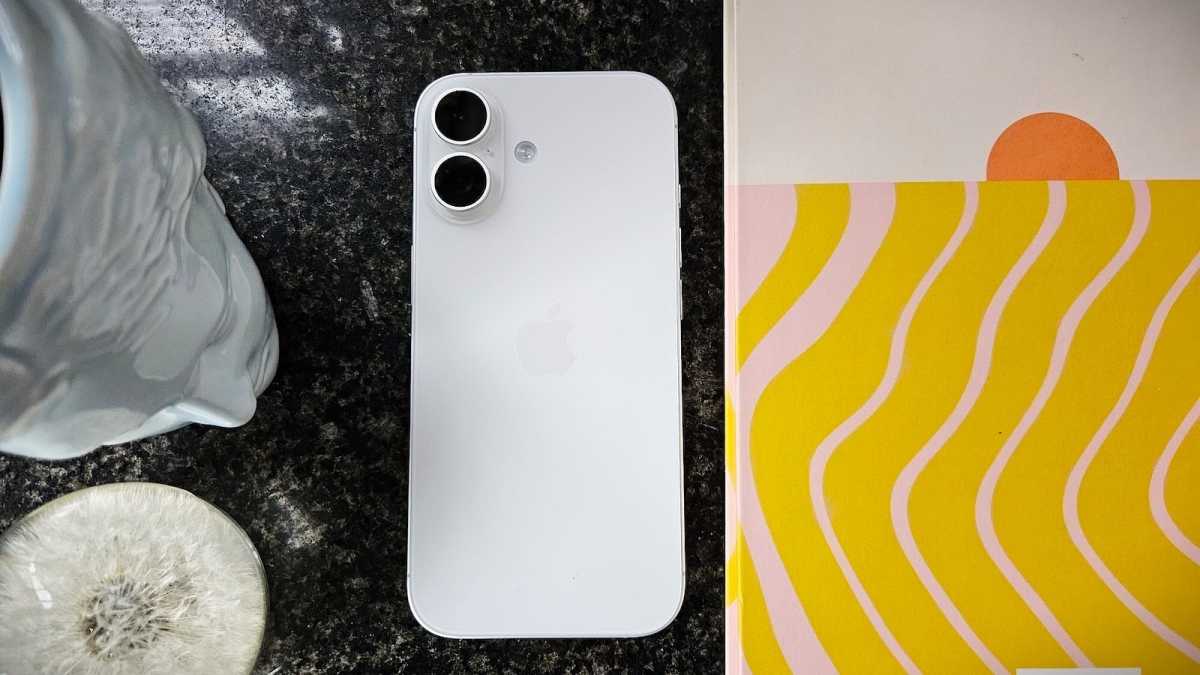
Emma Rowley / Foundry
Software and Apps
- Runs on iOS 26
- AI features mixed
The iPhone 17 runs the newly released iOS 26, with its Liquid Glass redesign. In spite of the fact that this is Apple’s biggest software redesign since iOS 7 in 2013, it’s already faded into the background in a ho-hum way.
In some respects, this is a good thing. I don’t want an interface that I constantly notice, and, in fact, my only issue with iOS 26 involves some third-party apps that are somewhat over-engineered to make the most of the new design. Slack is one such culprit, with a text box that glows irritatingly when you click on it.
I don’t tend to ask Siri for anything these days. We get along much better that way
The lock screen and home screen customisations are fun, although I imagine that most people will leave their icons alone rather than tinting them and making them harder to identify.
Other features are tiny, handy upgrades, like being able to change the default snooze timer.
I’ve found the AI features to be hit and miss. I initially loved Apple Music’s AutoMix, which means you never have to power through dead air between songs when running, but after a string of cacophonous mixes, I had to switch it off.
Meanwhile, Image Clean Up is useful if you don’t ask too much of it. Voicemail transcriptions have been a mixture of accurate and just alarmingly wrong, and I don’t tend to ask Siri for anything these days. We get along much better that way.
Apple will support the iPhone 17 with software updates and security patches for at least five years, and potentially up to seven.
Price and Availability
Once again, Apple has kept the iPhone 17 at the same price as its predecessor, although it’s actually a better deal.
For £799/$799 you’ll get 256GB of storage, 512GB for £999/$999. That’s much more cost-effective than last year, where the same £799/$799 only netted you 128GB of storage, while 256GB and 512GB cost £899/$899 and £1,099/$1,099 respectively.
This pricing puts it head-to-head with the Google Pixel 10. If you can’t decide between the two, check out our Pixel 10 versus iPhone 17 specs comparison. The Pixel 10 is the better bet if you want a zoom lens or solid AI features – but otherwise, it’ll probably come down to your preferred operating system.
You can buy the iPhone 17 in the UK from retailers including Apple, Currys and Amazon, or from EE, O2, Vodafone and other phone providers.
In the US, you can buy from a number of retailers, including Apple itself.
See more alternatives in our full guide to the best phones you can buy.
Should you buy the iPhone 17?
For most iPhone users, upgrading isn’t a question of if but when. Let’s not kid ourselves: we’re all locked into the ecosystem and sooner or later, we’ll be buying another iPhone. iPhone super fans and big spenders will enjoy the Pro models this year, and those who want a pocket-sized talking point will opt for the Air.
But for the rest of us, who likely have an ageing model and are wondering whether it’s worth going for the new iPhone 17 or getting last year’s model at a discount, I’d say that this is the year to invest in a shiny new phone. Unless you already own an iPhone 16, you’ll notice a real difference if you’re upgrading.
Specs
- Operating system: iOS 26
- Display: 6.1-inch Super Retina XDR display
- Chipset: A19
- Storage: 256GB/512GB
- Rear Cameras: 48Mp f/1.6 main camera, 48Mp f/2.2 ultrawide camera
- Front camera: 18Mp f/1.9 Centre Stage camera
- Charging: USB-C fast PD 2.0 charging, 25W wireless MagSafe charging, 25W wireless Qi 2 charging, 4.5W reverse wired
- Connectivity: Wi-Fi 7, Bluetooth 6, 5G NFC
- Water resistance: IP68
- Dimensions: 149.6mm x 71.5mm x 7.95mm
- Weight: 177g
- Colours: Black, White, Mist Blue, Lavender, Sage

